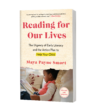Whether your child is already turning cartwheels or loves to watch gymnasts soar, stories about gymnasts can be a great way to keep them turning the pages. Picture-book biographies of famous gymnasts, in particular, show real-life heroes who worked hard, stayed strong, and followed their dreams—both on and off the mat.
From Olympic gold medalists to young athletes chasing big goals, the gymnastics books in this list bring energy, action, and heart to storytime. If you’re ready to leap into inspiring reads, check out these picks of gymnastics books for kids!
It’s fall, y’all! Time for the weather and the apples to get crisp, the pumpkins to plump, and the holiday season to get rolling. People from countries and religions around the world observe a wide variety of fall traditions that celebrate the harvest, change of seasons, and love of family and friends. To help you bring reading into your favorite fall celebrations or learn about those that are new to you, we’ve curated a list of a few favorite picture books for fall holidays.
Picture Books for Rosh Hashanah
Rosh Hashanah is the Jewish New Year and the beginning of the Jewish High Holy Days. During Rosh Hashanah, adherents reflect on their actions of the past year and examine where they have harmed others or done wrong, as well as how they can improve themselves and the world around them. It’s one of the most important holidays in Judaism.
Picture Books for Yom Kippur
Yom Kippur is the bookend for the Jewish High Holy Days. It comes 10 days after Rosh Hashanah. On this day, people atone for their wrongdoings. They apologize to those they have hurt and try to make their mistakes right.
Picture Books for the Mid-Autumn Moon Festival
This holiday is also called Moon Festival or the Mooncake Festival. It is traditionally celebrated in many parts of Asia, including China, Korea, Taiwan, and Vietnam. The day is based on the Lunar calendar and happens sometime between September and October. This holiday is a celebration of the Autumn harvest and is celebrated (as you might have guessed) at night! Families gather with lanterns, mooncakes, and starfruit to celebrate together.
Picture Books for Halloween
In the U.S. and an increasing number of countries around the world, October 31 means Halloween—pumpkins carved into jack-o-lanterns, spooky decorations, and costumed kids tramping door-to-door to the timeless refrain, “trick or treat!” All tricks aside, though, these books are total treats.
Picture Books for Día de Los Muertos
Día de Los Muertos means “Day of the Dead” in Spanish. It began in Mexico and is now celebrated in many Latin American countries and across the world. Día de Los Muertos celebrates the lives of loved ones who have died. Rather than being a sad and somber holiday, it is filled with love, flowers, sweet foods, candles, parties, and laughter.
Picture Books for Diwali
Diwali, or the Festival of Lights, is the biggest holiday of the year in India (though it is celebrated around the globe), observed by Hindus, Sikhs, Jains, and some sects of Buddhism. This holiday takes place over five days with prayers, feasts, decorations like intricate sand art called rangoli, and the lighting of lamps. Though different regions of India have different stories as to the origin of Diwali, all people recognize it as a holiday celebrating the triumph of good over evil.
Picture Books for Thanksgiving
American Thanksgiving is celebrated on the fourth Thursday of November. Originally, Thanksgiving was created to commemorate an Autumn harvest meal shared between Mayflower pilgrims and Wôpanâak Native Americans. In recent years, the focus and meaning of this holiday has shifted towards reflecting on family, thankfulness, and being together. Canadian Thanksgiving, with different origins but also a harvest feast, officially takes place the second Monday in October.
You may not be able to explore every country or celebrate every holiday in the world in person, but, as so often, books can be your ticket to carry you and your child wherever you want to go. We hope you’ll use this list of picture books as a jumping off point for delving into your own traditions with your little one and learning more about the world together. So grab a mug of cider and snuggle up with one of these fabulous fall books. Then add to the list by letting us know your favorite titles!
Like this list? Check out our other curated collections of kids’ books.
With a cross-country move and book deadline looming amid a global pandemic, a long, lazy summer vacation on a beach somewhere just wasn’t in the cards for my family. But we rallied in August to squeeze in a few long-weekend trips by plane, train, and automobile, so all wasn’t lost. In fact, we found that shorter trips, though less relaxing, had some surprising benefits. Most pertinent to this blog, they ramped up our reading, writing, and learning in unanticipated ways.
Having just a few days to work with, we had to bring greater diligence to researching, selecting, and scheduling our activities. Every minute mattered, so we had to find out in advance what was open and how close those attractions were to where we were staying and to one another. We also wound up doing more formal tours than we ordinarily would, as a shortcut to plunging right into the history, culture, and geography that made the destination special.
Interestingly, the brevity of the trips also heightened our attention to informational signs, pamphlets, and placards. Since we weren’t going to be there long and wouldn’t be returning again soon, everything got a more careful read than it otherwise might. We read about the craftsmanship and donors behind the Thai Pavilion at the Olbrich Botanical Garden in Madison, Wis. We stopped to contemplate Bisa Butler’s gorgeous portrait quilts at the Art Institute of Chicago and also read the fine print, including the playlist of songs she and her husband (a DJ) curated to go along with the exhibition.
This got me thinking about ways to build reading and writing into weekend escapes and other short family trips. Working literacy skills into regular life with kids is a favorite topic on this blog. Vacations always offer new and different opportunities for family time, and every chunk of time together is a new chance to weave in a little learning, too.
So, with that in mind, here are five short-trip-inspired activities that you can incorporate to maximize reading, writing, and learning along the way and make your travel with kids as educational as possible:
Read print copies of local publications.
The free tourism publications stocked in train stations and the city magazines for sale in grocery stores both provide wonderful reading materials for traveling families. The youngest kids can turn the pages and gaze at photos, as well as listen to us parents read relevant bits out loud. Older ones can engage with the print at their level, reading headlines and photo captions or the whole shebang.
I sent my daughter on a scavenger hunt of sorts right from her seat at the Amtrak station, just by asking her to fold down the corners of pages featuring attractions she wanted to check out. Sure, we could look this stuff up online, but the print format was more immersive (no flashing ads or distracting popups) and provided a welcome break from her iPad.
Plus, reading the publications from cover to cover introduced us to things we might have skipped past when clicking through web page links. We even read the pamphlets intended for visitors to our own city, finding local things to do that we’d never heard of.
The takeaway for kids: Reading can help you find cool places and fun activities you wouldn’t otherwise discover. It can also teach you details that might help convince your parents to take you there.
Chart your course with a paper map.
We’ve become so accustomed to dynamic turn-by-turn navigation on our phones and in our cars that we often overlook the brilliance of old-school paper maps. During our August travels, we navigated museums, gardens, nature trails, train tours, and neighborhoods all with the help of visitor guide maps.
Besides showing us how to get from Buddha Shakyamuni Seated in Meditation in Gallery 140 to Jordan Castille’s Barack in Gallery 295, the guides also offered some tidbits on the local landscape and history. We learned, for example, that The Art Institute of Chicago is located on the traditional homelands for the Ojibwe, Odawa, and Potawatomi Nations, and that the city of Chicago itself is home to one of the largest urban American Indian communities in the United States.
The street maps that accompany sight-seeing bus tours are another great reading resource for visualizing a city’s layout, seeing where must-see attractions are clustered, and familiarizing kids with map-reading.
For extra engagement, consider letting your child take the lead on deciphering the map and guiding the family.
The takeaway for kids: Maps are miniature versions of real-life locations, so reading them can help you chart your course.
Find regional specialties on restaurant menus and at farmer’s market stalls.
One of the joys of travel is experiencing different food and drinks than you find at home. Encourage kids to get in on the fun by scouting out things that are different from whatever they normally eat at home or order at your local restaurants.
Treat it like a scavenger hunt and have them dive into menus and ingredient lists to discern what seasonings, food pairings, and cooking techniques set the destination’s dishes apart. What makes a pizza Chicago-style? Exactly what kind of fish are they frying every Friday in Madison? How is frozen custard different from ice cream?
Even if you wind up at the same old chain during a travel stop, encouraging your child to read the menu for themselves (or even—gasp—try something other than their usual dish) will up the learning and make the experience fresher for you, too.
The takeaway for kids: Menus tell stories about the origin and preparation of food, and reading them can help us find yummy favorites and point us toward new things to try.
Watch time fly with bus schedules, itineraries, and terminal signage.
There’s no better place to learn the vocabulary of travel than when you’re on the road. Show kids your itinerary and point out key features like arrival and departure times, gate numbers, and special boarding instructions.
Point out the directional signage in airports and train stations, or along the highway. It’s not always obvious to kids that you know where to go because of what you’re reading as opposed to innate knowledge or past experience.
Pro tip: When teaching travel words (or any vocabulary), tell your child what the word means, give an example, and then also give a counter-example or non-example to deepen their understanding.
For instance, you might share that arrival is the process of getting somewhere. Then when you, say, land at an airport, explain that you’ve just arrived in the arrivals hall. You could also point to the words arrivals and departures on signage and explain that you departed from point A and have arrived at point B. A non-example of arrival would be staying somewhere. Explain that after you’ve been in the terminal for a bit, you’re no longer arriving. Rather you’re sitting, standing, and staying awhile. These are the kinds of examples, comparison, and contrast of similar words that help kids grasp shades of meaning.
The takeaway for kids: Reading signs, schedules, and itineraries helps us get where we’re going on time.
Write to savor memorable experiences or express local inspiration.
All of the ideas above can be deepened or extended with the help of writing. Kids of all ages can record their thoughts, process their experiences, and make memories on the road if you provide paper, crayons, markers, or pencils.
Give your child a small journal to encourage writing about their travels, or just offer writing materials in the moment. We forgot to bring a little notepad on one museum visit and my daughter improvised by writing a rap on the back of a business card. Later, back at the hotel, she began writing a novel on an app she downloaded onto her iPad.
These weren’t journal entries or school assignments, but creative, authentic writing inspired by what she was seeing and experiencing while away from home—proof that literacy needn’t feel like homework.
The takeaway for kids: Literacy is a two-way street. You can take in all of the print surrounding you in the world; read, interpret and use it for your good; and also add to the body of language in the world by creating some writing of your own.
How do you make your travel with kids educational? Share your ideas below or message me on social media!
At a time when we need to reinvent a world of hope, literacy is more important than ever.
Audrey Azoulay, UNESCO Director General
Literacy offers a beacon of hope. Yet, according to UNESCO, some 763 million children and adults around the world lack basic literacy skills. That’s a huge number. Luckily for all of us, though, there are many incredible people and organizations striving to improve literacy around the world. And the best part is that you can help, too, just by supporting them!
Below, read about seven wonderful literacy initiatives in various parts of the world, which are always looking for donations, volunteers, and books. The nonprofits listed here are close to my bookworm heart. Each one has a specific goal and way to build reading and writing in its target community or area. There are also so many other wonderful projects and nonprofits supporting literacy around the world, so I invite you to find one that calls to you and get involved.
Reading is Fundamental
Reading is Fundamental makes my heart sing. They have truly thought about literacy from the point of view of the child, the caregiver, and the teacher. The organization has multiple programs to help children in a myriad of ways.
They give away new books to kids, offer a supplemental reading program for kindergarten through third-grade students, operate an interactive digital library, and host an online portal with customizable assistance and resources for parents and teachers.
Their online center, Literacy Central, is pitched for adults helping little ones read. It offers a full spectrum of lesson plans, games, and related reading ideas. Within their online programs and ebooks, the organization uses technology to enhance the reading experience for kids. For example, they use Beeline software to put digital text in different colors, so as to help children read line breaks. They also use technology that allows users to change the fonts of digital text to Dyslexie font for people with dyslexia. And parents or teachers can scan a physical book’s ISBN in the Literacy Central app to get to a page with ideas dedicated to that specific book.
In 2019, the group partnered with Mr. Reading Rainbow himself, LeVar Burton, to acquire Skybrary. Developed by Burton as a new evolution of Reading Rainbow, Skybrary is a digital library with floating islands of content that has everything you loved about this classic TV show—books, real-world videos, and lessons. Burton works as advisor for Skybrary and continues to create content for it, so today’s kids can grow up listening to stories and going on adventures with the same teacher many of their parents did. It’s truly magical. But you don’t have to take my word for it, you can try it yourself!
Get involved: Make a financial donation, volunteer, or partner with Reading is Fundamental.
Room to Read
This incredible nonprofit supports educating girls around the world, something that’s also close to my heart: The group’s main purpose is to advocate for gender equality in education and improved literacy for girls. They create libraries, donate books, and train teachers, among their multiple programs.
Another unique and important feature of Room to Read is that 87 percent of the leadership and board members are from the countries being served. So they create programs that they understand will best aid those communities, rather than outsiders imposing what they think is best. They work with local governments, communities, and schools to create excellent educational programs and opportunities for girls. They strive for systemic change, not just quick fixes, again making them stand out in the field.
Get involved: You can donate financially, host or join a book-a-thon, get your local school involved in a fundraiser, join their book club, share their newsletter, and spread the word on social media.
Imagination Library
I’m from Austin, Texas, and if there’s one thing we take as seriously as reading, it’s music. So of course, I wanted to focus on the wonderful nonprofit work from one of the best musicians in the world, Dolly Parton. Dolly Parton began her Imagination Library because her own father never learned to read. She didn’t want any other children to feel embarrassed or held back by their lack of access to books.
Dolly Parton’s Imagination Library sends every registered child one free, new, age-appropriate book every month. Children can receive books from birth until they turn five years old. The initiative has donated over 150 million books (including audio and Braille books) since 1995. It began serving one small part of Tennessee and now operates in the United States, Australia, Canada, the United Kingdom, and Ireland.
Intrigued? Try watching Dolly read bedtime stories from the Imagination Library’s YouTube channel or watching a documentary about the project, called The Library That Dolly Built (available on multiple streaming services).
Get involved: Become a community champion and bring the program to your city. If your city already has a program, you can donate financially or volunteer with your local program.
Indigenous Literacy Foundation
Around the globe, indigenous populations have been denied access to adequate education. The Indigenous Literacy Foundation in Australia aims to repair that damage. They supply books to indigenous children and support literacy efforts like daily story times, especially in remote areas of Australia. The foundation also strives to publish children’s books by indigenous authors that are intended for indigenous populations.
To date, they’ve reached speakers of up to 26 different languages in 400 remote communities! They have donated over half a million books and published 103 books by indigenous authors. This level of dedication and support in a chronically underserved population is why I love to support this valuable group.
Get involved: If you happen to be in Australia, you can become a volunteer or host one of the group’s Great Book Swaps. If not, you can donate money, buy merchandise, or, if you own a business, donate a portion of your proceeds. They also greatly encourage people to follow and share on social media.
El Buen Samaritano
You might be familiar with this nonprofit from our previous post on Austin Literacy Nonprofits. Based in my hometown of Austin, Texas, El Buen Samaritano offers many services, including educational support. It has five levels of ESL classes for children and adults, after-school and summer programs for kids, and school readiness programs. The organization offers its classes in both English and Spanish.
El Buen Samaritano really sparkles because of its commitment to strengthening families by creating opportunities for families to learn and play together.
Get involved: Volunteer at El Buen Samaritano or at one of their many events. They also accept monetary donations.
Worldreader
As an educator for more than 16 years, I have seen the ways children learn broaden to include more technology at younger ages. Some of this change is unwelcome, but it’s undeniable that digital learning can be a helpful supplement to a broader literacy strategy that also includes face-to-face, person-to-person conversation, book sharing, and reading instruction. Unfortunately, children in low-income areas often lack access to tablets, smart phones, and laptops, as well as curriculum and learning materials. Worldreader tackles this problem head on.
Worldreader works in countries around the world to get digital books, as well as the technology required to access them, into the hands of children. They also train parents, teachers, and librarians on how to use the tools and platforms.
Get involved: Donate, sponsor a school, or subscribe to their newsletter and spread the word.
Behind the Book
This organization does truly well-designed and inspirational work. Based in New York City, Behind the Book aims to tackle low literacy rates in public schools from kindergarten through 12th grade. This directly benefits children of color and children who are English language learners, which I am incredibly passionate about. Behind the Book has a team that comes from the communities it supports, and their well-thought-out methods are backed by great intentions and actions.
The group has donated more than 17,500 books since 2003. They help teachers create strong curriculum that goes along with the Common Core State Standards and is culturally relevant. Behind the Book also gets authors into classrooms to talk to students about reading, writing, and exploring their creative process. They also create reading and writing workshops for students, encouraging children to get hands-on in growing their reading abilities.
Get involved: Volunteer, donate funds, or attend one of their fundraising events.
Literacy is the key that opens the door to almost every other avenue in life. By supporting organizations like these that are working to help end illiteracy around the world, you can be a part of handing millions of people that key.
But volunteering with or donating to one of these nonprofits is just one way to get involved. You can also start your own book drive for a local library or children’s shelter, or create a Little Free Library in your neighborhood. You can even simply take time and use your voice to teach others you know about the issue—and all the ways to help.
Enjoy this post? Please share it on social media.
Whether you and your family root for your college team or love to watch your favorite NFL players, you’ll all be a fan of these football picture books! These sweet reads capture the magic of a fall day in the stadium: the excitement in the stands, the heartbreaking losses, the underdog victories, the athletic feats, and the inspiring stories of the players themselves.
Aspiring football players and all sports fans—kids and adults alike—will enjoy learning about legendary players and the importance of teamwork, perseverance, and chasing your dreams. Kick off story time with these 10 inspiring reads, and then let us know your favorite titles.
To learn more about Ernie Barnes, try Between the Lines: How Ernie Barnes Went from the Football Field to the Art Gallery, an award-winning picture book by Sandra Neil Wallace.
For fans of By My Brother’s Side, explore seven other books by the Barber brothers, including Kickoff!, Go Long!, and Red Zone.
Read more: If the little fans in your life enjoy these football picture books, try reading our other lists of sports books, too.
What are your favorite sports reads for kids?
During an elementary school supply drop-off visit at my daughter’s school one day, I was struck by how much preparation must have gone into coordinating 60 minutes of activity for the hundreds of students and families in attendance. As we approached the front entrance, the principal and staff members welcomed us, ushered us toward classrooms, and answered our questions. Once inside, vibrantly decorated chalkboards, doors, and walls greeted us. And we thoroughly enjoyed the chance to organize her desk and locker, easing pleasantly into the start of the new year.
We were spared all of the meetings, emails, checklists, and minutiae that go into pulling off events like this. We didn’t even have to labor over our part of the equation, gathering the school supplies themselves. We didn’t trudge through the aisles of stores picking out notebooks, crayons, and pencils like when I was a kid. No, we ordered the whole bundle in one fell click via a link the school had emailed us.
Thinking of all the work the staff and teachers put into making things easier for us got me pondering what families should be doing to make things easier for teachers. What are our obligations as partners with teachers in our children’s education? What contributions can we make to kids’ school success through the habits we instill, activities we plan, or attitudes we cultivate at home? Where does teachers’ work end and parents’ work begin? Or, more accurately, how should we connect, collaborate, and communicate to reinforce, amplify, and support one another’s work for the kids’ benefit?
There are so many things we as parents can do at home and before kids start kindergarten to get them ready for school, from preparing them for what to expect and how to act at school to dressing them for success (it’s not quite what you think). But once they’re through the gates, our part is far from done. Here are a few touchstones for what parents should do once kids are in school:
Know the Expectations
A critical factor in having a good school year is defining a good school year. Yet too few parents have a clear understanding of the academic expectations of their children’s teachers, schools, districts, or states. Instead, all too often we look to lagging indicators like grades on individual assignments, report cards, or standardized test results to tell us how our child is doing. A better approach is to look ahead and learn what our kids are expected to know or be able to do by year’s end—as well as how their teacher plans to get them there.
This eye-opening exercise can give you a sense of the breadth and complexity of what students are expected to learn. It can alert you to opportunities to cultivate developmentally appropriate knowledge and skills at home. It can also highlight areas of weakness that may warrant extra help beyond school or home, for example through tutoring, field trips, or enrichment programs.
When my daughter was younger, I paid particular attention to the foundational reading standards because I knew those skills pave the way for all later subject-matter learning. Once she was a fluent reader, I locked in on the grade-level writing standards. These include capacities that will serve her well lifelong, such as how to:
- Write arguments to support claims with clear reasons and relevant evidence, using credible sources and demonstrating an understanding of the topic or text.
- Write informative/explanatory texts to examine a topic and convey ideas, concepts, and information through the selection, organization, and analysis of relevant content.
- Write narratives to develop real or imagined experiences or events using effective technique, relevant descriptive details, and well-structured event sequences.
- With some guidance and support from peers and adults, develop and strengthen writing as needed by planning, revising, editing, rewriting, or trying a new approach.
- Use technology, including the Internet, to produce and publish writing as well as to interact and collaborate with others; demonstrate sufficient command of keyboarding skills to type a minimum of three pages in a single sitting.
- Gather relevant information from multiple print and digital sources; assess the credibility of each source; and quote or paraphrase the data and conclusions of others while avoiding plagiarism and providing basic bibliographic information for sources.
Basically, she should be fully capable of writing a blog of her own. Here’s how you can find out what your child needs to learn this year: Check out the Common Core State Standards to see what 41 states, the District of Columbia, four territories, and the Department of Defense Education Activity agree kids should be able to know and do at each grade level. For states like Alaska, Texas, Indiana, Florida, and Virginia that have their own standards, Google the state name followed by “learning standards” or “curriculum standards” to find details.
Read School Communications
We’re all suffering from information overload, but one great way to build goodwill with your child’s teacher from day one is to actually read the information that comes home in a timely fashion. And then do your best to respond warmly, enthusiastically, and quickly, as you would expect your child to. The teacher’s job of educating your child and their classmates is already taxing. Don’t add the extra burden of educating you on information they’ve previously shared.
It may not be ideal for you to have to sift through a child’s backpack for a paper flier, read each item in classroom e-newsletters, or log into the school website for the field trip calendar, but it’s best to do it anyway. As Vlada Lotkina, CEO of parent-teacher communication platform Classtag, observes, teachers’ day-to-day reality is challenging, too. “Not only do teachers face conflicting parent expectations and preferences for when, what, and how to communicate, but they also have to manage this and a multitude of admin tasks on top of their core teaching responsibilities,” she says.
In short, answering needless inquiries from parents takes away from the time they can devote to teaching our kids. So before you dash off the email asking how your child will find the right classroom when they get off the school bus, see the note that came home explaining that the teacher will be greeting kids in the play yard, starting at 7:35, with a sign with her name on it.
Also make a special note of what method of communication each teacher prefers. It’s easier and more effective for you to adapt to their style than to get them to switch to yours. Remember, every teacher deals with dozens of parents. It’s unreasonable to ask for elaborately tailored communications, e.g. to text you, but email your wife, and chat in person with the babysitter at pick-up. Be flexible and read the information that comes your way, however and whenever it arrives.
And if you feel so moved, advocate for communication solutions that leverage technology to reach parents through their preferred methods, so that the personalization doesn’t fall on the teachers’ shoulders.
Put the Home in Homework
There’s a great deal of debate circulating about the merits of homework, particularly with younger children. Does it actually help them master the intended material? Does it steal time from family meals, bonding, and other learning and enrichment activities? Does it create stress and anxiety for parent and child? The answer of course is: It depends. It depends on the nature and amount of the assignments; the intentions and effectiveness of the teacher; the maturity, skills, and disposition of the child; what else the family has going on; and innumerable other factors.
So, in my mind, as a parent, the most pertinent question isn’t whether homework in general is good or bad, but how our family in particular is going to approach whatever homework our child receives. In this way of thinking, parents need to know:
- What kind of homework will be assigned and how frequently? E.g., will there be daily assignments and/or longer-term special projects?
- How long is the child expected to spend doing homework?
- What kind of parent participation in homework does the teacher expect? E.g., should parents be reading along, going over instructions, answering questions, checking results, signing off on it?
Sometimes you may have to ask the teacher about these things in an email or at back-to-school night. Often you won’t. Veteran and proactive teachers tend to provide this kind of info upfront. We’ve just got to notice and digest it.
My daughter’s third-grade teacher sent weekly emails offering insight into the work ahead and what appropriate parent support would look like. One memorable dispatch arrived with “Rigor, Time Management & Expectations” in the subject line. Inside, she broke down her intention to provide learning experiences that were academically, intellectually, and personally challenging to students; why such rigor was different for each student; and how students’ ability to prioritize tasks, plan ahead, and complete assignments on time was another matter altogether. She made it clear that our role was to check in and ask our kids questions about their research reports and other assignments, but not to take over or do intensive teaching. She’d provided ample instruction, examples, rubrics, and so on during class time.
Other times, you will need to ask your child’s teacher for more information, either on their overall approach or on specific subsections of the curriculum or assignments. Request the details you need to help your child succeed. For example, see our post on asking teachers about spelling instruction: Nine Questions to Ask Your Child’s Teacher About Spelling.
For example, when my daughter was heading into a new classroom with a new teacher at a new school in a new state, I had a lot to learn about the workload, grading policies, and parent expectations there. But I was already clear on my primary parent duties. These are things every parent should be striving to achieve, within your particular constraints and abilities:
- Provide a quiet, well-lit, well-stocked, distraction-free space to do the work.
- Ask questions that help the child prioritize and plan how they’re going to get their work done.
- Support them in keeping the commitments they make to themselves around when and how they’ll work.
- Use specific language to praise the work ethic, organization, and tenacity they show in completing assignments, to reward their effort and encourage more of it.
Supplement with Intention
An email from a one-on-one tutoring company landed in my inbox with the subject line, “A Successful School Year for Your Student.”
“Now more than ever, your child deserves an effective, reliable learning experience,” the message inside read. “We can help.” To illustrate the point, it featured pictures of three children of diverse ages and ethnicities happily engaged in learning activities—a teen reading a thick hardback book, a young girl smiling and gazing off as if visualizing the spelling of a word, and a little boy seemingly deep in thought with a blue pencil hovering above his composition book. The takeaway was clear: One way parents can help kids “read and comprehend to their potential” is to hire a tutor.
Should parents have to pay to secure basic literacy skills for their kids? No. Do they? Often, yes. The reality is that private tutoring is a major player in the reading landscape, with implications for how, when, and whether kids fulfill their reading potential. I looked up statistics on tutoring nationally and internationally, and found a major uptick in tutoring for early-elementary students. Before the COVID-19 pandemic hit, the sector was nearing $800 million in annual revenue. Large franchises like Kumon experienced rising enrollment among preschoolers, according to market research firm IBISWorld. Some of this demand is driven by parents bent on creating super-achieving students, but much of it comes from a simple desire to get a struggling child to “grade level.”
I wish it weren’t the case, but the booming supplemental education industry props up reading achievement on a national scale. Getting a sense of your child’s prospects for the year—what’s expected of them, where they stand, and how successfully their school and teacher may move them along—could lead you to call in some reinforcements. If that’s the case, know that you’re far from alone.
But supplementation isn’t always about bringing in the big guns. Often parents can make an impact by bringing real-world context and experiences to school subjects. Wisconsin history is a focal point of the fourth grade curriculum in our state, so we took a little trip to Madison before school started that year. We visited the capitol and began accumulating the little points of reference and insights that my daughter could build on when her class dove into the topic later that year. As she gets older, I continue to keep an eye out for fun ways to connect while building on what she’s learning at school.
Like this post? Please share it!
Did you ever wonder why storybooks for kids are filled with illustrations or visuals? It’s because it’s proven that using illustrations alongside text helps in increasing children’s learning retention. According to Dr. Haig Kouyoumdjian, “Words are abstract and rather difficult for the brain to retain, whereas visuals are concrete and, as such, more easily remembered.” This is the power of visual imagery in learning.
There are a lot of fun ways to encourage young kids to enjoy engaging with books and print. One way is combining words and pictures together. Just like storybooks! We know that a lot of busy parents are looking for free and easy resources online to use in teaching their kids—especially those who are just starting out in reading. That’s why we love to create printables for use at home that will help kids enjoy learning as much as we do.
As Halloween is fast approaching, we created a free Halloween printable for busy and creative parents. It’s a word spinner that consists of Halloween-related words and illustrations from A to Z. It is a very easy DIY project that your kids can help you out with. All you need is a home printer and some simple materials that you likely have at home.
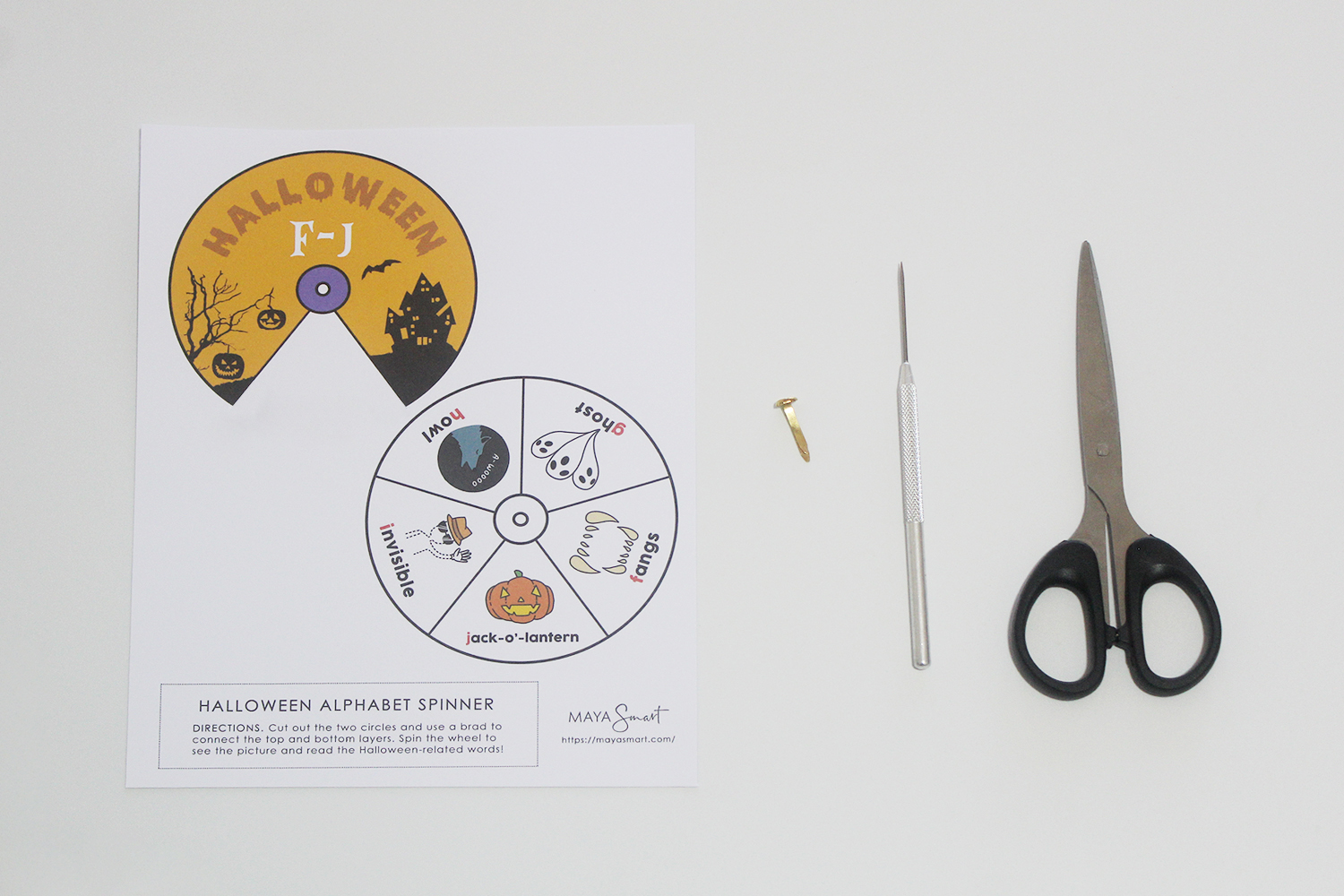
Materials:
- Printer
- Cardstock — 5 pieces (to print free Halloween alphabet spinner template)
- Scissors
- Paper piercer (or any sharp object)
- Brad pin
Cost: $3 or so for a whole pack of brad pins
Step 1: Print out the free Halloween alphabet spinner template. This is best printed on cardstock paper instead of regular paper, so that it will not be flimsy when you spin it.
The printable consists of five pages dividing the 26 letters of the alphabet into five sets: A–E, F–J, K–O, P–T, and U–Z. You can make all the Halloween alphabet spinners at once, or space them out as you see fit to keep the learning activity fresh and fun for your child.
Tip: If you begin with just one, choose the printable that includes the first letter of your child’s name. Teaching children letter names and sounds beginning with their own first initial is a good way to engage them and keep their attention.
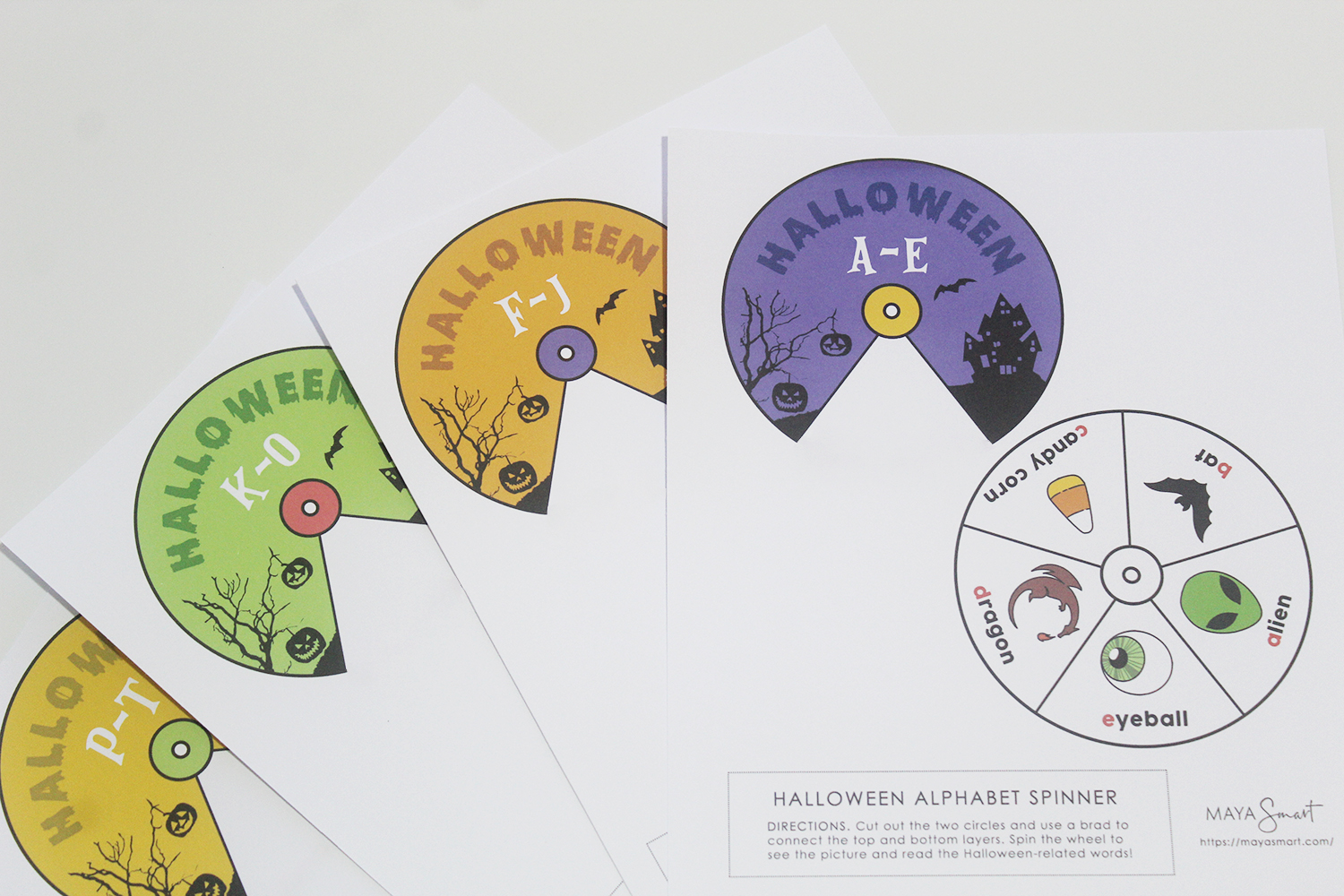
Step 2: Next, you need to cut out the two circles from the printable. The top cover is not a perfect circle, but looks like a Pac-Man shape.
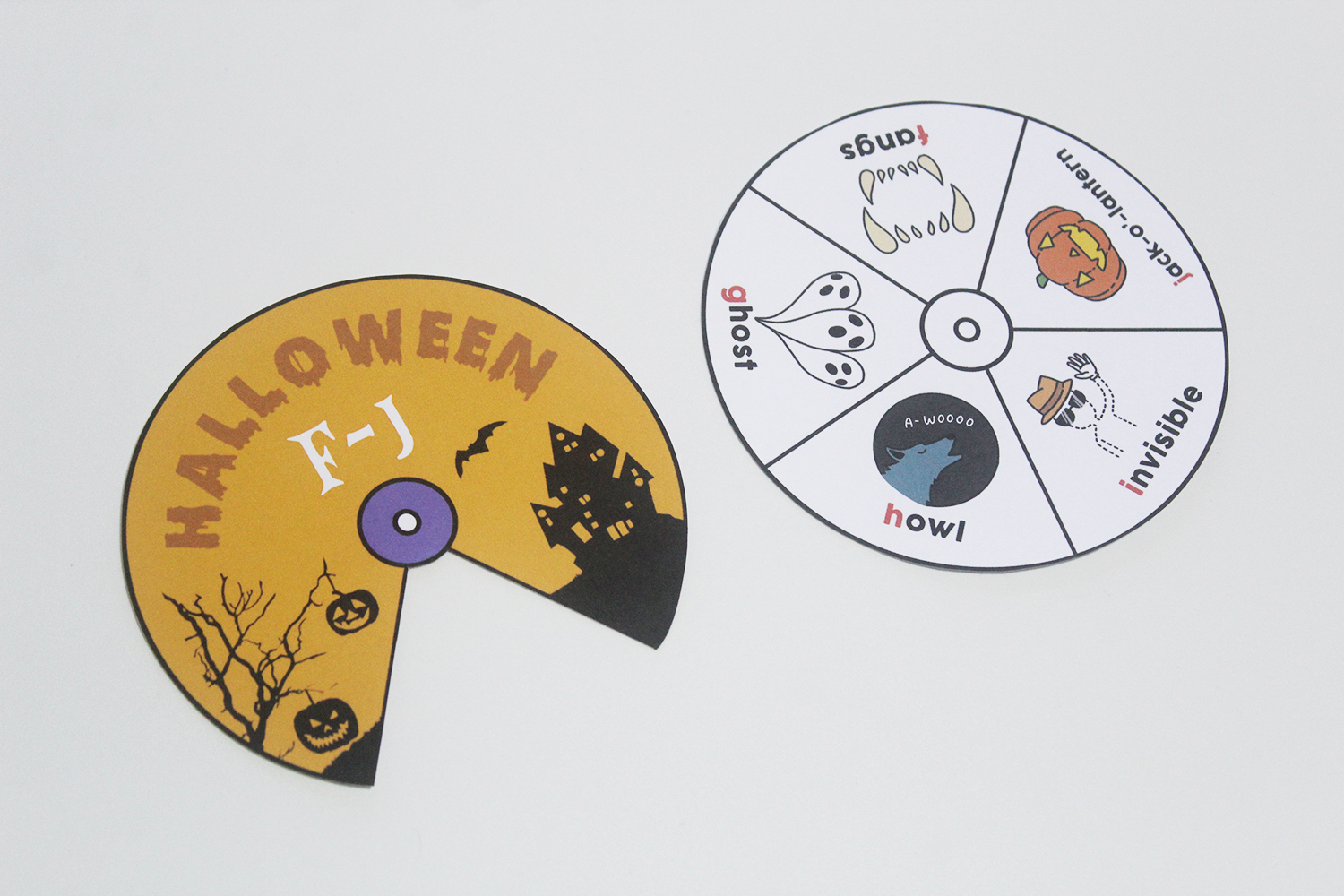
Step 3: When you are done cutting, it’s time to poke holes in the center part of both circles using a paper piercer or any sharp object. This will help you in inserting the brad smoothly and avoid scrunching the paper. If your child is helping you out with this project, make sure that he/she is supervised when using any sharp objects.
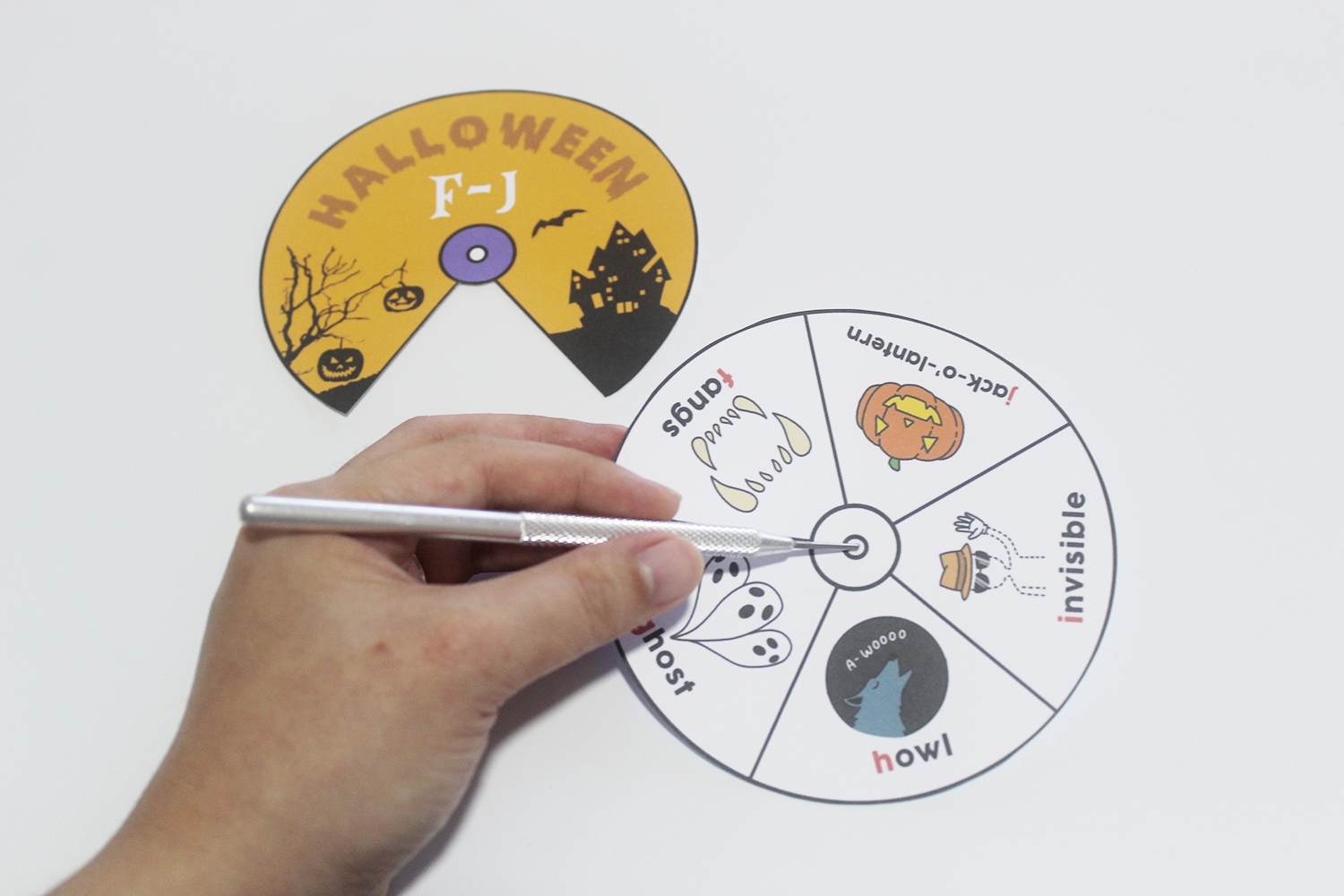
Step 4: Now it’s time to assemble the spinner! Place the cover on top of the bottom layer and insert the brad pin through the holes.
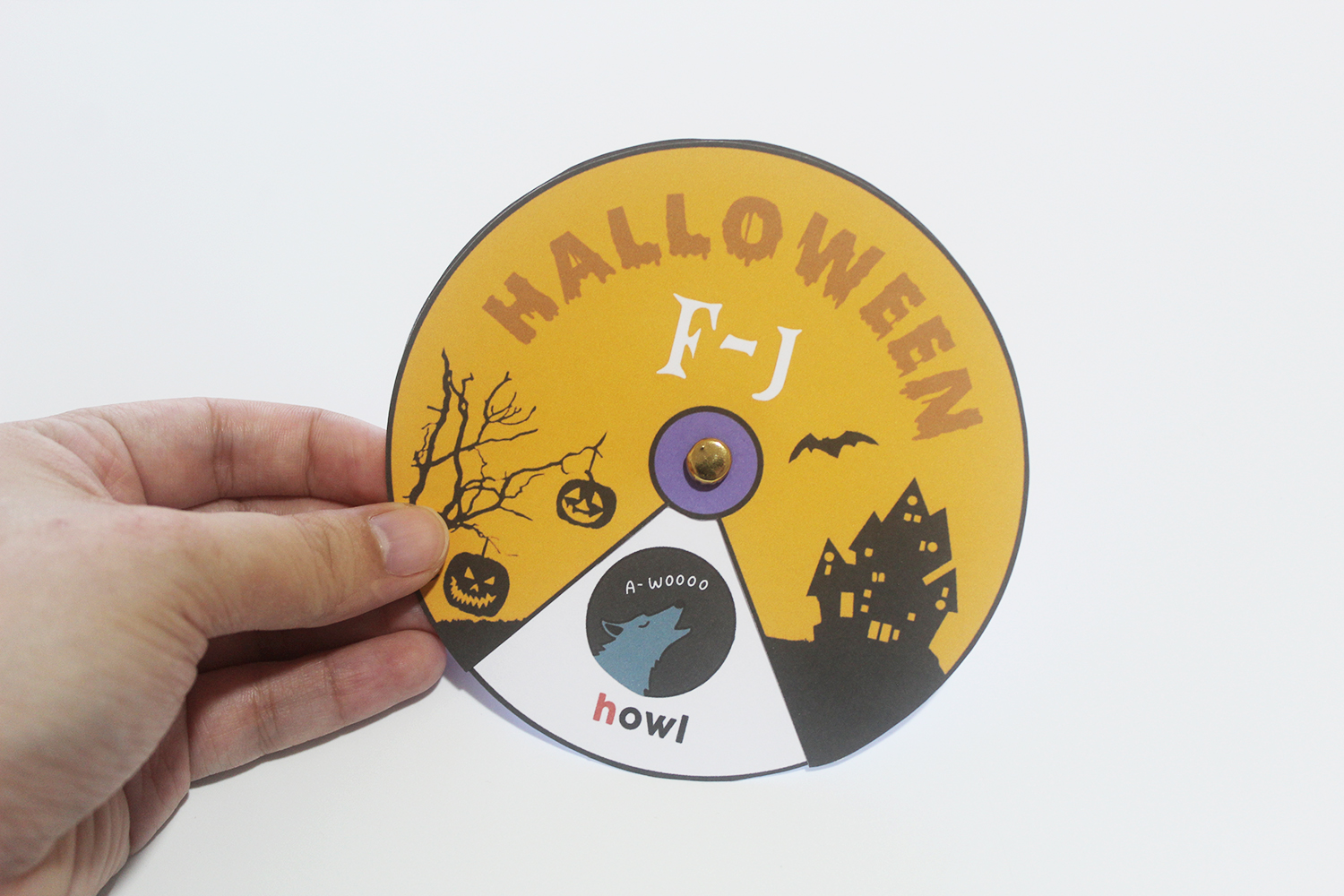
Step 5: Separate and bend the prongs at the back to hold both circles together. Try spinning the cover wheel to see if the brad works well and smoothly.
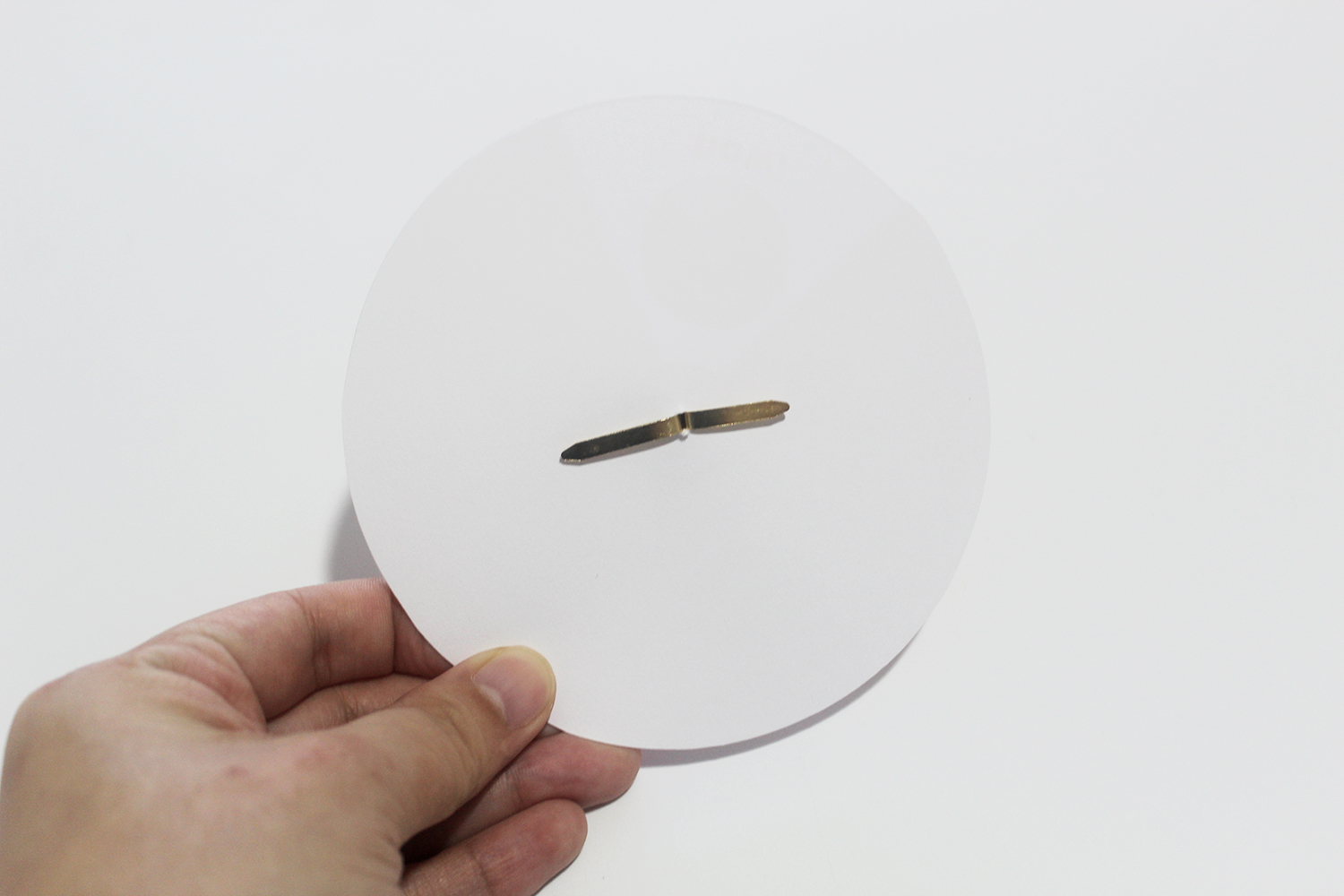
Step 6: Create all five templates to have a complete set of Halloween-related words from A-Z! Spin the wheel to uncover different Halloween-related words and photos.
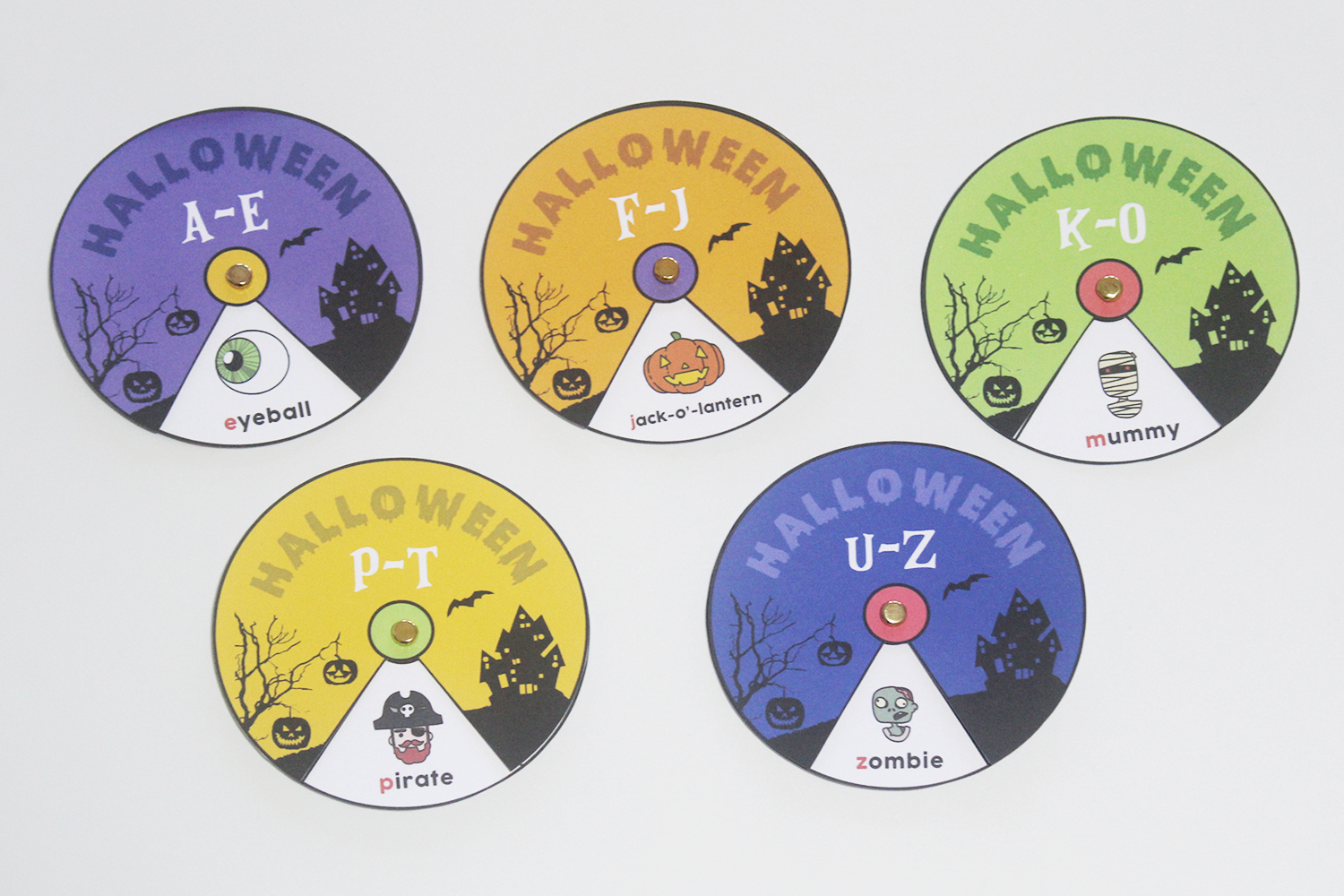
And you’re done! I hope this free Halloween printable alphabet spinner will help you create a fun learning experience with your child this Halloween season.
When you use it, highlight to your child the starting letter of each word, and help them match the initial sound to the letter. For slightly older kids, you can invite them to try to guess what some of the words will be in each letter group before spinning the cover to reveal the answers.
By Laila Weir
Raising little readers and writers means providing plenty of reading and writing material, which in turn can mean a whole lot of pencils, pens, and markers trailing around your home (or your kid’s backpack).
Get organized with these cute DIY pencil cases that your child can make in just a few easy steps from common household items. These crafts offer an eco-friendly and fun way for kids to bring their own flair to personalized holders for use at home or on the go. Rather than buying new, you’ll reduce your impact on the environment and create your own unique pencil case.
In our super-simple tutorials, you’ll learn to upcycle a plastic container and a plastic bag into adorable containers for your child’s writing implements. Both pencil cases close, so you can toss them into bags for school or outings, but they make cute organizers for craft tables or homework corners around the house, too.
After you check out the tutorials below, scroll down to learn how to make a DIY pencil pinwheel. Kids will love using these special pencils, which are sure to jazz up writing time!
DIY Recycled Pencil Holder
With just a little glam, you can upcycle a plastic container into the perfect storage container for pencils, markers, and even crayons! There are so many different plastic containers for food that are the perfect size to repurpose into a pencil holder. We used a roasted peanut jar, but many different items that would have been headed for the recycling bin will work. This is a fun, easy, and environmentally responsible project to do with your kids. (Tip: If you want your container to close, remember you’ll need one that’s long enough to hold your pencils. Or use a shorter container to make an open-topped holder for a desk or craft table.)
DIY Easy Duct-Tape Pencil Case
In this brilliantly simple craft, you simply cover a large ziplock bag with duct tape to create a customized pencil case. (You will want to read our tutorial, though, for tips and tricks to make sure your project goes smoothly!) Use duct tape in a fun pattern to create a super-cute case, layer different colors to create your own pattern, or just use a single color to make a quick and easy pencil bag. You can even punch three holes along the bottom of your case and it will fit perfectly in a binder. The duct tape reinforces your bag, so this can be a good way to give new life to a still-usable plastic bag that’s been used to hold other items.
Bonus: DIY Pencil Pinwheels
It’s a pencil! It’s a toy! These handmade pencil pinwheels will make writing so much fun. They make a cute back-to-school gift for children or teachers, and they’re sure to add a playful touch to literacy activities with kids of all ages at home, too. Just note that this craft involves using a straight pin, so consider supervising safety when kids put their pencil pinwheel to use.
If you and your little one love these crafts, check out our decoupage notebook tutorial to add a personalized notebook to your collection of customized literacy supplies, too.
How else are you sprucing up your child’s writing corner? We’d love to hear your ideas!
By Laila Weir
Little kids love crafts, and they love dressing up. That’s probably why making beaded jewelry is so popular with the preschool and kindergarten sets. It also builds important fine motor skills, but guess what–with a simple adaptation, you can also use this fun activity to teach early reading and spelling.
The seeds to literacy are planted long before kids start school, so it’s crucial for parents to introduce key knowledge to kids early on. And the best way to do it is to weave learning into everyday activities and fun with your kids. In that spirit, this simple game leverages the fun of beading to teach children early reading and spelling, helping turn practice into play.
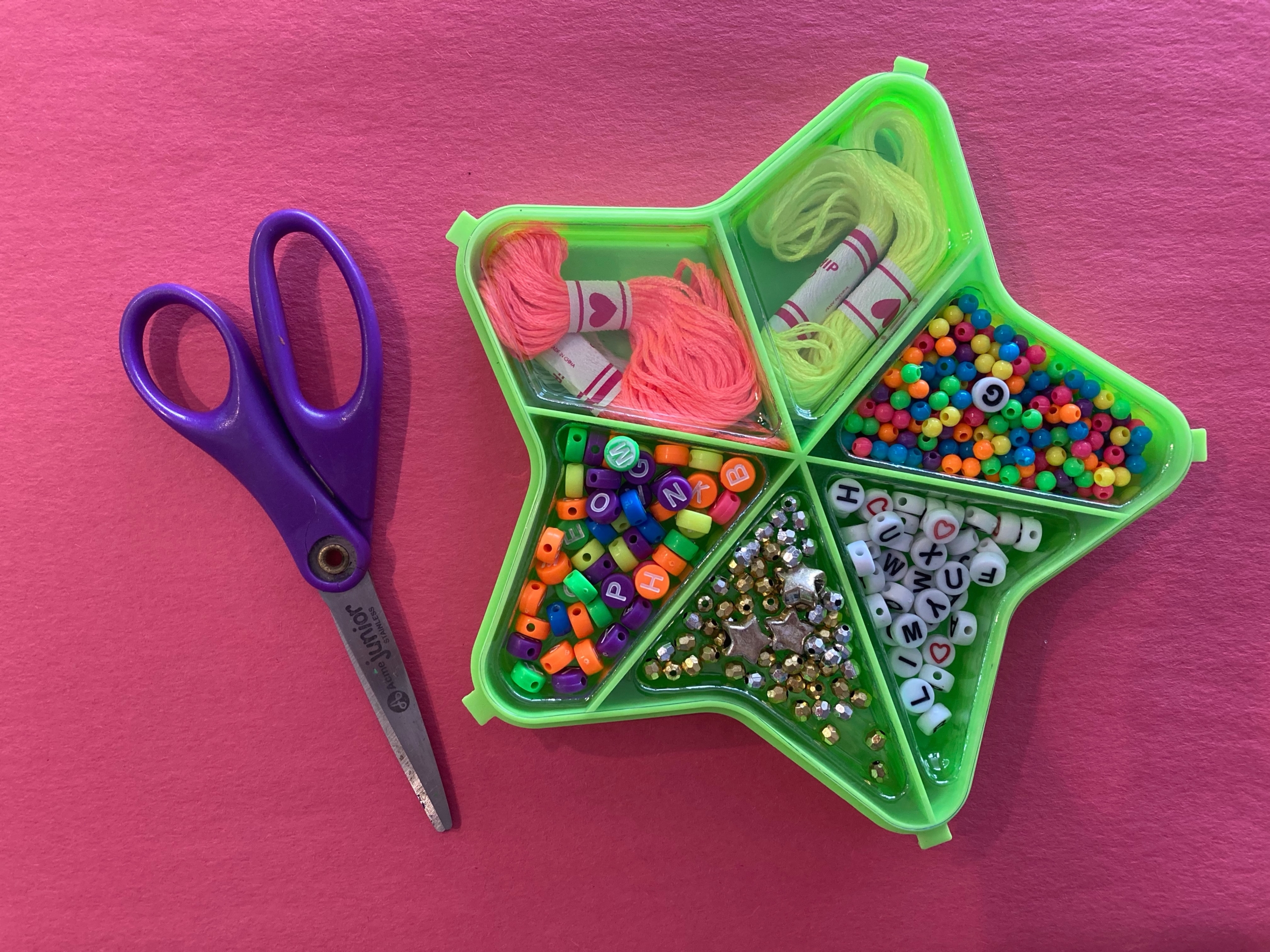
Materials:
- Alphabet beads (plus other beads if desired)
- String
- Scissors
Cost: Under $10
Step 1: Write out a list of words you want to practice spelling and reading with your child. Then identify which letters you’ll need to form those words. Ideally, you’ll want to think of several words that can be spelled with the same letters.
For a simple start, plan on CVC words — consonant, vowel, consonant — which are easy to sound out. For example, you could make the words top, mop, cat, hat, mat, pat, pot, sat, and sap using the letters T, P, M, C, H, S, O, and A. As your child advances in skill, you can use these same letters to make words with consonant blends, like stop, past, shop, post, etc.
Step 2: Cut the same number of pieces of string as the number of letters you’ll be using. For the example above, cut eight pieces. Make the pieces long enough to fit around your child’s finger, leaving plenty of excess to tie them securely. (Note: If you want to spell words that need to repeat letters, you should make two of the letters that repeat.)
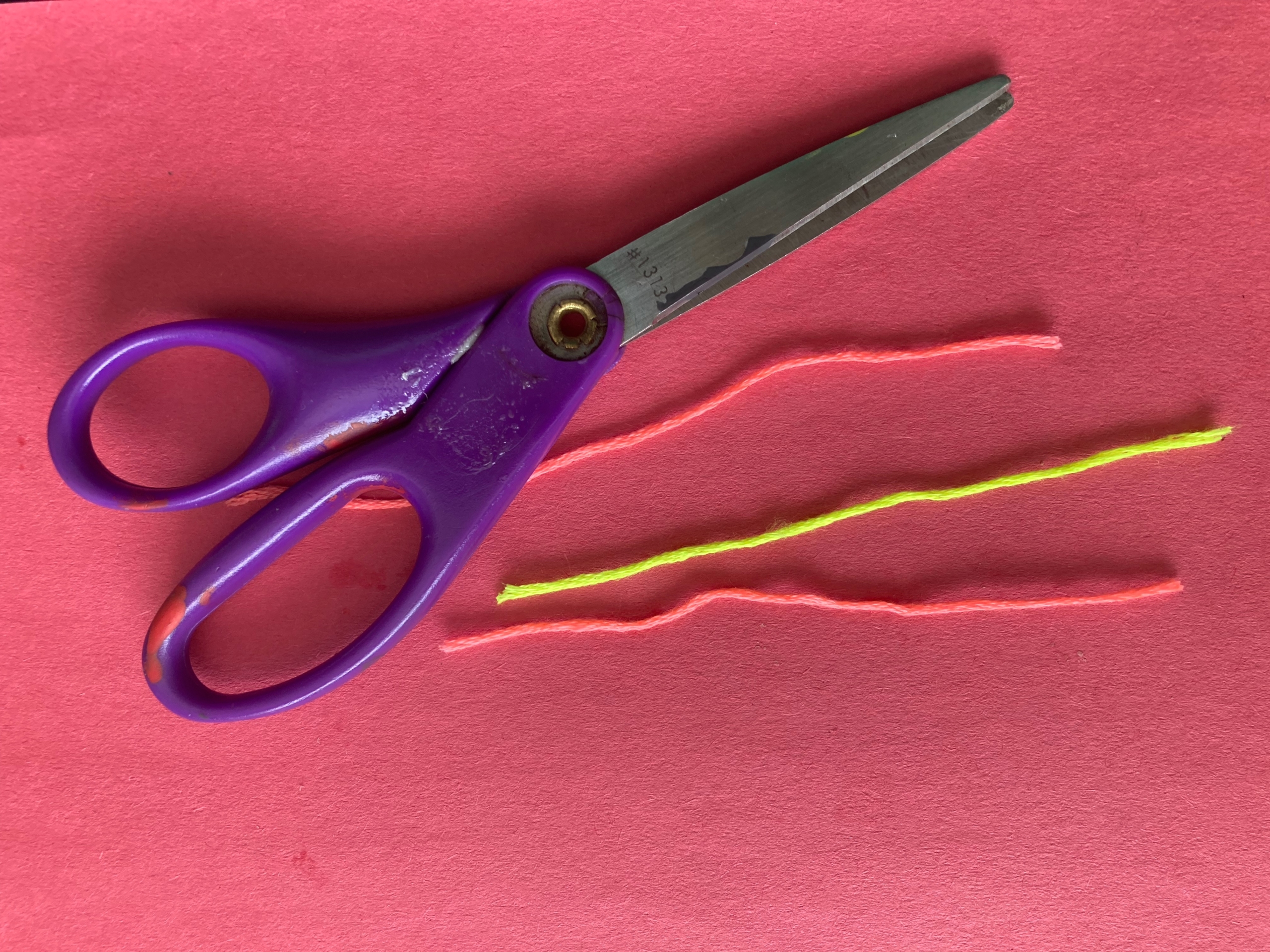
Step 3: Help your child put one of your target letters on each piece of string. You and your child can add other beads in any pattern you like to beautify your creations. Then tie the pieces together to make rings.
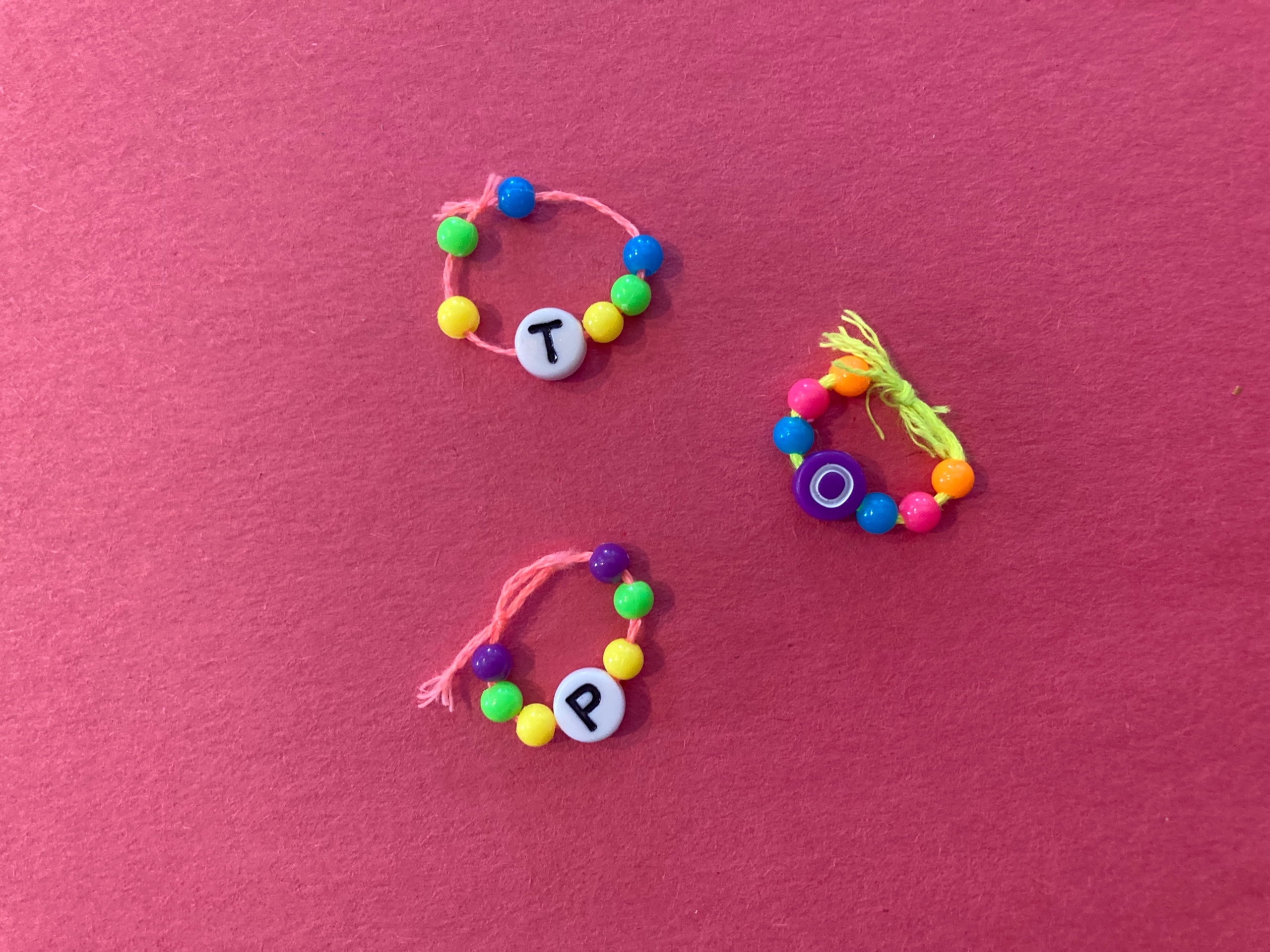
Step 4: Help your child sound out one of your target words and line up the letter rings they need to spell it. Then slide those rings onto their finger and help them read their word! Repeat with as many words as they can find with the letters you’ve used.
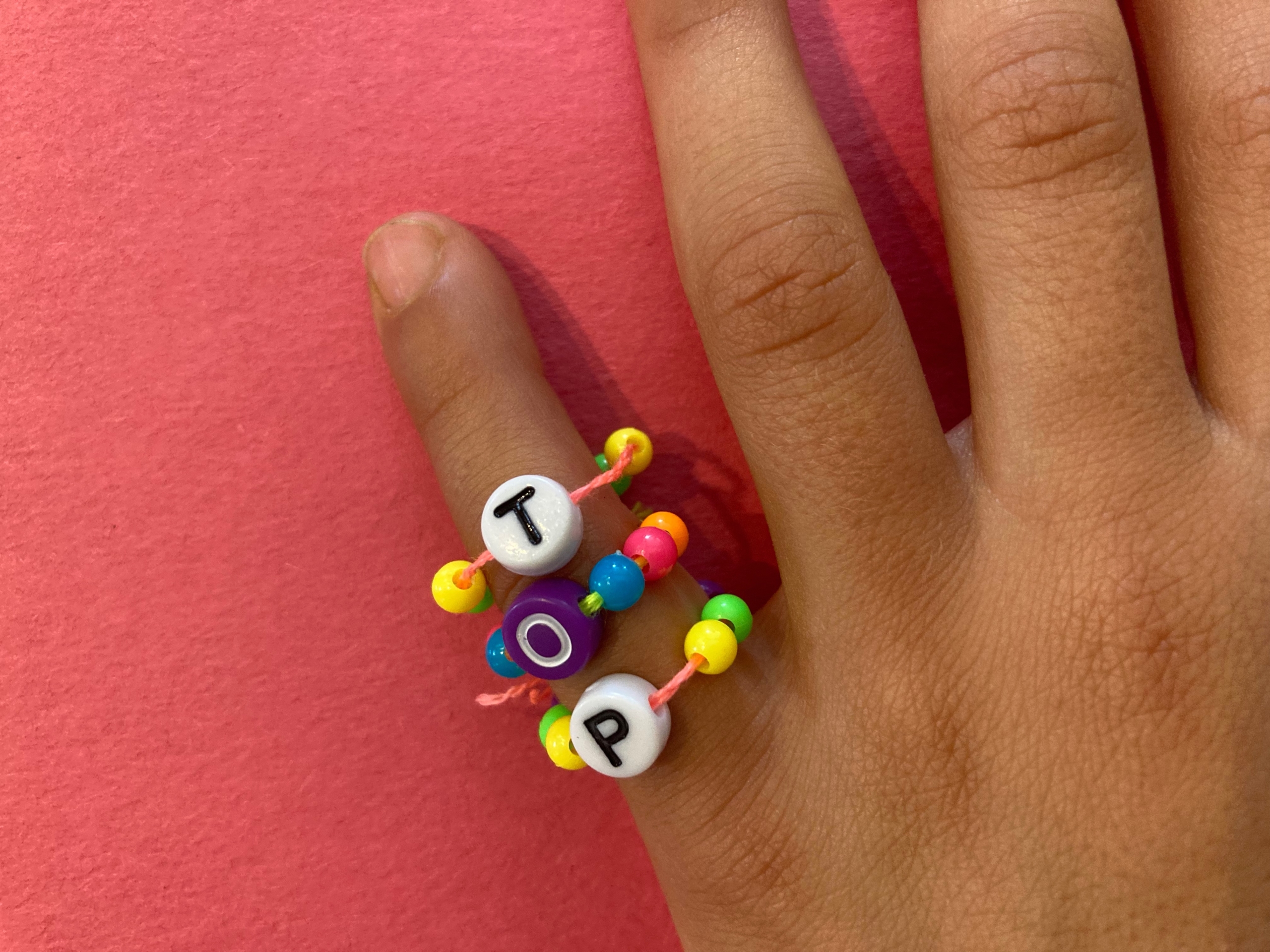
When your child runs out of steam, don’t push them to keep spelling. Kids tire (and get frustrated) quickly, and forcing the matter takes the fun out of it fast. Instead, stash your letter rings to pull out again for brief sessions in the future. They’ll make a great addition to an arsenal of practice-through-play teaching materials. They’re also small enough to keep in your bag for some quick entertainment on the go.
Tip: Start a drawer or shelf with a variety of fun crafts and games that reinforce key skills. Do some of our other literacy crafts with your little one and add them to your stash, as well. Here are some to get you started: a personalized ABC board game, DIY storytelling cards, rhyming Go Fish, literacy Game of War, a conversation hearts spelling game, and a creative sound slider reading tool.
Kids often think of heroes as big, powerful people doing monumental deeds. True heroes, however, come in all shapes and sizes, and not all heroic acts are monumental.
These 10 picture books about animal heroes feature a diverse group of creatures, including dogs, a mule, bees, and even a brave little koala bear. Heroic traits such as kindness, cleverness, and acceptance are highlighted, along with more conventional heroic traits such as bravery and loyalty.
Learning about other animals helps to strengthen children’s sense of wonder, develop empathy for other beings, and cultivate respect for the creatures around them. These 10 picture books about animal heroes also demonstrate a plethora of heroic traits—traits that kids can use to be heroes every day, such as kindness, understanding, and tenacity.


